TABLE OF CONTENTS
FOREWORD
1. INTRODUCTION
1.1 What is a confined space?
1.2 Who has health and safety duties in relation to a confined space?
1.3 What is required in managing risks?
1.4 How to determine whether a space is a confined space
2. ROLE OF DESIGNERS, MANUFACTURERS AND SUPPLIERS
2.1 Eliminating or minimising the need to enter a confined space
2.2 Entry and exit
3. HOW TO IDENTIFY THE HAZARDS
3.1 What hazards are associated with a confined space?
3.2 Other hazards
4. HOW TO ASSESS THE RISKS
5. HOW TO CONTROL THE RISKS
5.1 The hierarchy of control
5.2 Eliminate the need to enter a confined space
5.3 Minimise the risks..........................................................19
5.4 Entry permits
5.5 Isolation
5.6 Atmosphere
5.7 Communication and safety monitoring
5.8 Entry and exit procedures
5.9 Signs and barricades
5.10 Information, instruction and training
5.11 Maintenance of control measures
6. EMERGENCY PROCEDURES
7. HOW TO REVIEW CONTROL MEASURES
APPENDIX A – CONFINED SPACE CRITERIA
APPENDIX B – SAMPLE CONFINED SPACE ENTRY PERMIT
LIST OF AMENDMENTS
This Code of Practice on how to manage the risks associated with confined spaces in workplaces is an approved code of practice under section 274 of the Work Health and Safety Act (WHS Act).
An approved code of practice is a practical guide to achieving the standards of health, safety and welfare required under the WHS Act and the Work Health and Safety Regulations (the WHS Regulations).
A code of practice applies to anyone who has a duty of care in the circumstances described in the code. In most cases, following an approved code of practice would achieve compliance with the health and safety duties in the WHS Act, in relation to the subject matter of the code. Like regulations, codes of practice deal with particular issues and do not cover all hazards or risks that may arise. The health and safety duties require duty holders to consider all risks associated with work, not only those for which regulations and codes of practice exist.
Codes of practice are admissible in court proceedings under the WHS Act and Regulations. Courts may regard a code of practice as evidence of what is known about a hazard, risk or control and may rely on the code in determining what is reasonably practicable in the circumstances to which the code relates.
Compliance with the WHS Act and Regulations may be achieved by following another method, such as a technical or an industry standard, if it provides an equivalent or higher standard of work health and safety than the code.
An inspector may refer to an approved code of practice when issuing an improvement or prohibition notice.
This Code of Practice has been developed by Safe Work Australia as a model code of practice under the Council of Australian Governments’ Inter-Governmental Agreement for Regulatory and Operational Reform in Occupational Health and Safety for adoption by the Commonwealth, state and territory governments.
A draft of this Code of Practice was released for public consultation on 7 December 2010
and was endorsed by the Workplace Relations Ministers’ Council on 10 August 2011.
This Code provides practical guidance on how to meet the requirements under the WHS Regulations in relation to work carried out in a confined space. It applies to persons conducting a business or undertaking who have management or control of a confined space, and to designers, manufacturers or suppliers of plant or structures that include, or are intended to include, a confined space.
This Code will help determine when a space is a ‘confined space’ for the purposes of the WHS Regulations, what the potential hazards are and how to eliminate or minimise the risks when carrying out work in a confined space.
This Code can also be used by workers and their health and safety representatives interested
in understanding the hazards and risks associated with confined spaces.
In providing guidance, the word ‘should’ is used in this Code to indicate a recommended course of action, while ‘may’ is used to indicate an optional course of action.
This Code also includes various references to provisions of the WHS Act and Regulations which set out the legal requirements. These references are not exhaustive. The words ‘must’, ‘requires’ or ‘mandatory’ indicate that a legal requirement exists and must be complied with.
Confined spaces pose dangers because they are usually not designed to be areas where people work. Confined spaces often have poor ventilation which allows hazardous atmospheres to quickly develop, especially if the space is small. The hazards are not always obvious and may change from one entry into the confined space to the next.
The risks of working in confined spaces include:
- loss of consciousness, impairment, injury or death due to the immediate effects of airborne contaminants
- fire or explosion from the ignition of flammable contaminants
- difficulty rescuing and treating an injured or unconscious person
- asphyxiation resulting from oxygen deficiency or immersion in a free-flowing material, such as grain, sand, fertiliser, water or other liquids .
Regulation 5: A confined space means an enclosed or partially enclosed space that:
- is not designed or intended primarily to be occupied by a person; and
- is, or is designed or intended to be, at normal atmospheric pressure while any person is in the space; and
- is or is likely to be a risk to health and safety from:
- an atmosphere that does not have a safe oxygen level, or
- contaminants, including airborne gases, vapours and dusts, that may cause injury from
fire or explosion, or - harmful concentrations of any airborne contaminants, or
- engulfment.
A confined space is determined by the hazards associated with a set of specific circumstances and not just because work is performed in a small space.
Confined spaces are commonly found in vats, tanks, pits, pipes, ducts, flues, chimneys, silos, containers, pressure vessels, underground sewers, wet or dry wells, shafts, trenches, tunnels or other similar enclosed or partially enclosed structures, when these examples meet the definition of a confined space in the WHS Regulations.
A confined space does not include a mine shaft or the workings of a mine.
The following kinds of workplaces are also generally not confined spaces for the purposes of the WHS Regulations:
- places that are intended for human occupancy and have adequate ventilation, lighting and safe means of entry and exit, such as offices and workshops
- some enclosed or partially enclosed spaces that at particular times have harmful airborne contaminants but are designed for a person to occupy, for example abrasive blasting or spray painting booths
- enclosed or partially enclosed spaces that are designed to be occasionally occupied by a person if the space has a readily and conveniently accessible means of entry and exit via a doorway at ground level, for example:
- a cool store accessed by a LPG forklift to move stock – although the use of a LPG forklift in a cool store can be hazardous, the door at ground level means that once the alarm is raised, escape and rescue can happen quickly
- a fumigated shipping container with a large ground level opening will facilitate easy escape and rescue.
Trenches are not considered confined spaces based on the risk of structural collapse alone, but will be confined spaces if they potentially contain concentrations of airborne contaminants that may cause impairment, loss of consciousness or asphyxiation.
A person conducting a business or undertaking has the primary duty under the WHS Act to ensure, so far as is reasonably practicable, that workers and other persons are not exposed to health and safety risks arising from the business or undertaking.
The WHS Regulations include specific obligations on a person conducting a business or undertaking who has management or control of a confined space.
Designers, manufacturers and suppliers of plant or structures that include a space that is intended, or is likely to become, a confined space must eliminate the need for any person to enter a confined space and eliminate the risk of inadvertent entry or, if this is not reasonably practicable, ensure safe means of entry and exit and minimise risks to the health and safety of any person who enters the confined space.
Officers, such as company directors, have a duty to exercise due diligence to ensure that the business or undertaking complies with the WHS Act and Regulations. This includes taking reasonable steps to ensure that the business or undertaking has and uses appropriate resources and processes to eliminate or minimise risks that arise from entry into confined spaces.
Workers must take reasonable care for their own health and safety and that their work does not adversely affect the health and safety of other persons. Workers must comply with any reasonable instructions given relating to confined space entry permits, risk control measures and emergency procedures, and should carry out work in a confined space in accordance with any relevant information and training provided to them.
Emergency service workers are not required to comply with some requirements for entering confined spaces when either rescuing a person or providing first aid to a person in the space (WHS Regulations 67 and 68).
Duties in relation to confined spaces include:
- managing health and safety risks associated with a confined space, including risks when entering, working in, on or near a confined space, as well as the risk of inadvertent entry
- ensuring, so far as is reasonably practicable, that a worker does not enter a confined space until all the duties in relation to the confined space have been complied with, for example entry permit requirements
- establishing first aid and rescue procedures to be followed in the event of an emergency in the confined space.
The WHS Regulations also set out requirements for specific controls measures including communication and safety monitoring, signs, isolation of connected plant and services, and controls to maintain a safe atmosphere within the confined space.
Regulation 34-38: In order to manage risk under the WHS Regulations, a duty holder must:
- identify reasonably foreseeable hazards that could give rise to the risk
- eliminate the risk so far as is reasonably practicable
- if it is not reasonably practicable to eliminate the risk – minimise the risk so far as is reasonably practicable by implementing control measures in accordance with the hierarchy of control
- maintain the implemented control measure so that it remains effective
- review, and if necessary revise, risk control measures so as to maintain, so far as is reasonably practicable, a work environment that is without risks to health and safety.
This Code includes guidance on how to manage the risks associated with a confined space by following a systematic process that involves:
- identifying hazards associated with confined spaces
- assessing the risks associated with these hazards
- implementing risk control measures
- reviewing risk control measures.
Guidance on the general risk management process is available in the Code of Practice: How to Manage Work Health and Safety Risks.
Section 47: The WHS Act requires that you consult, so far as is reasonably practicable, with workers who carry out work for you who are (or are likely to be) directly affected by a work health and safety matter.
Section 48: If the workers are represented by a health and safety representative, the consultation must involve that representative.
Consultation with workers and their health and safety representatives is a critical part of managing work health and safety risks.
You must consult your workers who are involved in carrying out work in or near a confined space during the process of identifying hazards, assessing risks and implementing control measures.
It is often more effective to involve a team of people in the risk management process to draw
on a range of knowledge and experience, for example knowledge of:
- the particular confined space under assessment
- any work methods that will be used in or near the confined space
- confined space hazards and control measures.
Section 46: If more than one person has a duty in relation to the same matter, each person with the duty must, so far as is reasonably practicable, consult, co-operate and co-ordinate activities with all other persons who have a work health or safety duty in relation to the same matter.
Sometimes more than one person conducting a business or undertaking will have the same duty in relation to a confined space. For example, a person who owns the plant or structure that contains the confined space will have management or control of the confined space. A contractor engaged to carry out work in the same space will also have management or control of the confined space at the time that work is being carried out. In these situations, effective communication, co-operation and co-ordination of activities between duty holders is essential to ensure that risks associated with the confined space are eliminated or minimised as far as is reasonably practicable.
Further guidance is available in the Code of Practice: Work Health and Safety Consultation,
Co-operation and Co-ordination.
A confined space is determined by the structure and a specific set of circumstances. The same structure may or may not be a confined space depending on the circumstances when the space is entered. Entry to a confined space is considered to have occurred when a person’s head or upper body enters the space.
A space may become a confined space if work that is to be carried out in the space would generate harmful concentrations of airborne contaminants.
Temporary control measures such as providing temporary ventilation or achieving a satisfactory pre-entry gas test will not cause a confined space to be declassified. For a confined space to be declassified as a non-confined space, it needs to have undergone sufficient changes in structure and use to eliminate all inherent hazards that define a confined space.
The following flowchart will help to determine whether a space is a ‘confined space’ for purposes of the WHS Regulations.
Appendix A provides examples to illustrate how a confined space is determined.
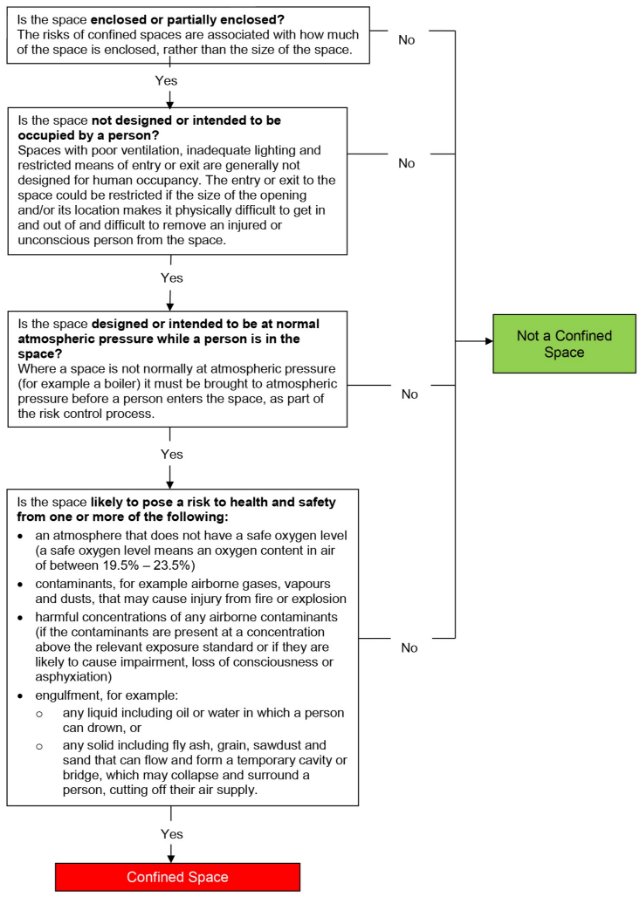
The design, manufacture or modification of any plant or structure that includes a confined space can significantly affect the risks associated with confined spaces. Thoughtful design can eliminate the need to enter a confined space or eliminate the risk of inadvertent entry. The design stage should consider the whole life cycle of the plant or structure, from manufacture and use through to demolition and disposal.
Regulation 64: A designer, manufacturer, importer or supplier of a plant or structure, and a person who installs or constructs a plant or structure must eliminate the need to enter a confined space and eliminate the risk of inadvertent entry. If this is not reasonably practicable, then:
- the need for any person enter the space must be minimised so far as is reasonably practicable
- the space must be designed with a safe means of entry and exit, and
- the risk to the health and safety of any person who enters the space must be eliminated
or minimised as far as is reasonably practicable.
The following features should be incorporated in the design and manufacturing stages:
- provision of outlets and facilities for cleaning, to eliminate the need for entry
- use of lining materials that are durable, require minimal cleaning and do not react with materials contained in the confined space
- design of the structure and mechanical parts to provide for safe and easy maintenance,
to reduce the need for persons to enter.
If it is not reasonably practicable to eliminate the need to enter the confined space or the risk
of inadvertent entry, then any risk associated with entry to and exit from the space must be minimised. Entry to and exit from a confined space is safer when openings (access points)
are large and located in a position that allows for persons and equipment to pass easily
through them.
Where relevant, the following features should be incorporated at the design, manufacture
and installation stages:
- Access points (including those within the confined space, through divisions, partitions or obstructions) should be large enough to allow people wearing the necessary protective clothing and equipment to pass through, and to permit the rescue of all people who may enter the confined space.
- A safe means of access to and within the confined space, such as fixed ladders, platforms and walkways should be provided. Further guidance is available in AS 1657 Fixed platforms, walkways, stairways and ladders – Design, construction and installation.
- Access points should be unobstructed by fittings or equipment that could impede rescue and should also be kept free of any obstructions during work in the confined space. If equipment such as electrical cables, leads, hoses and ventilation ducts are required to pass through an access hole, a second access point may be needed.
- There should be enough access points to provide safe entry to and exit from the confined space. For example, the spacing of access holes on sewers (or in the case of large gas mains, the absence of such access holes over considerable lengths) may affect both the degree of natural ventilation and the ease with which persons can be rescued.
Identifying hazards involves finding all of the things and situations that could potentially cause harm to people. The types of substances previously stored in a confined space (however briefly) will indicate the sorts of hazards that may be present. Substances stored in a confined space may result in a lack of oxygen, airborne contaminants or a flammable atmosphere within the confined space. Other hazards may arise from work activities, products or by-products in or around the confined space.
Regulation 34: In managing the risks associated with a confined space, the person conducting the business or undertaking must identify reasonably foreseeable hazards that could give rise
to the risk.
Small entrances and exits make it difficult to rescue injured workers or to get equipment in
or out of the confined space. In some cases, entrances and exits may be very large but their location can make them difficult to access. For example, accessing pits or openings high up
in silos may require the use of ladders, hoists or other devices, and escape and rescue from such spaces may be difficult in emergency situations.
The following table illustrates the kinds of harmful atmospheres that may be present in a confined space, and how they may be created.
Source | Examples |
Substance stored in the confined space or its by-product(s) | - build-up of hydrogen sulphide in sewers and pits
- release of toxic substances e.g. hydrogen sulphide in tanks
of decomposing organic material, especially when the material is disturbed
|
Work performed in the confined space | - use of paints, adhesives, solvents or cleaning solutions
- welding or brazing with metals capable of producing toxic fumes
- exhaust fumes from engines used in the confined space
- painting or moulding glass-reinforced plastics
|
Entry of natural contaminants e.g. groundwater and gases into the confined space from the surrounding land, soil or strata | - acid groundwater acting on limestone with the potential to produce dangerous accumulations of carbon dioxide
- methane released from groundwater and from decay
of organic matter
|
Release of airborne contaminants | - when sludge, slurry or other deposits are disturbed or when scale is removed
|
Manufacturing process | - residues left in tanks, vessels etc., or remaining on internal surfaces can evaporate into a gas or vapour
|
Entry and accumulation of gases and liquids from adjacent plant, installations, services or processes | - the contamination of underground confined spaces by substances from plant in the vicinity of the confined space
- carbon monoxide from the exhaust of LPG-powered forklifts operating in, or in the vicinity of, the confined space
|
Air normally contains 21% oxygen by volume, although oxygen levels of 19.5% — 23.5% by volume are considered to be safe.
Some situations can cause the level of oxygen to dramatically decrease, leading to an oxygen-deficient atmosphere and possible asphyxiation. This may occur, for example, if oxygen in the atmosphere is:
- displaced by gases produced during biological processes, for example, methane in a sewer
- displaced during purging of a confined space with an inert gas to remove flammable or toxic fumes
- depleted inside metal tanks and vessels through surface oxidation (for example, when rust forms)
- consumed during combustion of flammable substances
- absorbed or reacts with grains, wood chips, soil or chemicals in sealed silos.
Too much oxygen can increase the risk of fire or explosion. Oxygen-enriched atmospheres may occur if:
- chemical reactions cause the production of oxygen, for example certain reactions with hydrogen peroxide
- there is a leak of oxygen from an oxygen tank or fitting while using oxy-acetylene equipment.
A fire or explosion requires the presence of three elements: an ignition source, air and a fuel (gas, vapour or mist) capable of igniting. A flammable atmosphere is one in which the flammable gas, vapour or mist is likely to exceed 5% of its lower explosive limit (LEL).
Flammable atmospheres in confined spaces may result from the evaporation of a flammable residue, flammable materials used in the space, a chemical reaction (such as the formation
of methane in sewers), or from the presence of combustible dust (such as that in flour silos).
If an ignition source, such as a sparking electrical tool or static on a person, is introduced into
a space containing a flammable atmosphere, an explosion is likely to result.
Engulfment means to be swallowed up in or be immersed by material, which may result in asphyxiation. Examples of materials that may pose a risk of engulfment include plastics, sand, liquids, fertiliser, grain, coal, coal products, fly ash, animal feed and sewage. Stored materials such as sand and grain can form a crust or bridge when a container is emptied from below, leaving the top layer in place. Workers walking on the bridge or working below the bridge
on the floor of the container may be engulfed if a bridge collapses (see Figure 1).
Figure 1 Example of ‘bridging’ which may result in engulfment
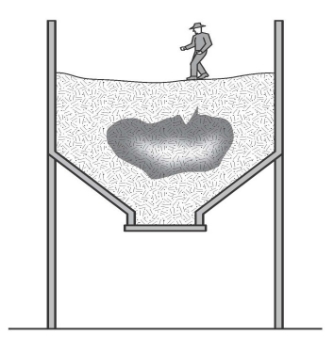
The uncontrolled introduction of substances such as steam, water or other liquids, gases or solids may result in drowning, being overcome by fumes or other harm depending on the nature of the substance.
Vehicles and LPG forklifts operating close to the opening of the confined space can cause a build-up of exhaust gases, including carbon monoxide, in the space.
Contact with micro-organisms, such as viruses, bacteria or fungi, may result in infectious diseases, dermatitis or lung conditions such as hypersensitivity pneumonitis. Sewers, grain silos and manure pits are examples of confined spaces where biological hazards may be present.
Exposure to mechanical hazards associated with plant may result in entanglement, crushing, cutting, piercing or shearing of parts of a person’s body. Sources of mechanical hazards include plant such as augers, agitators, blenders, mixers and stirrers.
Electrical hazards may cause electrocution, shocks or burns, and can arise from cables, transformers, capacitors, relays, exposed terminals and wet surfaces where electrical circuit and electrically powered plant are used.
The nature of a confined space could give rise to an increased likelihood of skin contact with surface contaminants. Skin contact with hazardous substances may result in immediate health effects such as burns, irritation or allergic dermatitis, or longer-term systemic effects.
Noise generated in a confined space from the use of plant, the work method or process may
be amplified due to reflections off hard surfaces. Exposure to hazardous noise may result in hearing loss, tinnitus and other non-auditory health effects. Hazardous noise may also prevent workers hearing warning signals and distract workers from their work.
Further guidance is available in the Code of Practice: Managing Noise and Preventing Hearing Loss at Work.
Hazards arising from manual tasks may be exacerbated by physical constraints associated with working in a confined space. Additional hazards may arise from the use of personal protective equipment that restricts movement, grip and mobility.
Further guidance is available in the Code of Practice: Hazardous Manual Tasks.
The health effects associated with radiation depend on the type of radiation involved. Sources of radiation include radioactive sources, x-rays, lasers, welding flash, radio frequency and microwaves.
Environmental hazards associated with work in a confined space may cause or contribute to harm. Examples of environmental hazards include:
- heat or cold stress arising from the work, process or conditions
- slips, trips and falls arising from slippery surfaces or obstacles
- inadequate lighting.
Further guidance is available in the Code of Practice: Managing the Work Environment and Facilities.
Where the confined space has a vertical opening, there is a risk that people could fall in.
Traffic hazards are a concern where confined space entrances or exits are located on footpaths or roads. There is the potential for workers entering or exiting the space to be struck and injured by vehicle traffic.
Work done outside the space, but near openings to it, can contaminate the atmosphere inside the space. A common example is the exhaust gases from an internal combustion engine. There may also be potential for fire or explosion where hot work is done in areas next to confined spaces that contain flammable atmospheres.
Working in a confined space may impose additional physiological and psychological demands over and above those encountered in a normal working environment. Consideration should be given to a worker’s:
- physical ability
- ability to work in a restrictive space (for example claustrophobia)
- ability to wear the personal protective equipment required to do the work (for example respirators).
A risk assessment involves considering what could happen if someone is exposed to a hazard and the likelihood of it happening.
Regulation 66: A person conducting a business or undertaking must assess health and safety risks associated with the identified hazards of the confined space.
The risk assessment for a confined space must be undertaken by a competent person and be recorded in writing. The risk assessment must be reviewed and revised whenever any risks change.
Regulation 77: A copy must be kept for 28 days, or if a notifiable incident occurs in connection with the work to which the assessment relates, for 2 years after the incident occurs.
When undertaking a risk assessment to determine the risks requiring control the following factors should be considered:
- the atmosphere in the confined space, including whether testing or monitoring is to be undertaken
- the risk of engulfment of a person
- all proposed work activities, particularly those that may cause a change to the conditions in the confined space.
- the number of persons occupying the space
- the soundness and security of the overall structure and the need for lighting and visibility
- the identity and nature of the substances last contained in the confined space
- any risk control measures needed to bring the confined space to atmospheric pressure
- the number of persons required outside the space:
- to maintain equipment essential for the task being undertaken within the confined space
- to provide continuous communication with the persons within the confined space, and
- to properly initiate emergency response procedures
- risks associated with other hazards, such as noise or electricity
- arrangements for emergency response, for example first aid and resuscitation
- the physiological and psychological demands of the task and the competency of persons involved in the tasks or emergency response duties
- the adequate instruction of persons in any required procedure, particularly those that are unusual or non-typical, including the use and limitations of any personal protective equipment and other equipment to be used
- the availability and adequacy of appropriate personal protective equipment and emergency equipment for all persons likely to enter the confined space.
- the need for additional risk control measures, including:
- prohibiting hot work in adjacent areas
- prohibiting smoking and naked flames within the confined space and adjacent areas
- avoiding contamination of breathing air from operations or sources outside the confined space, for example, from the exhaust of an internal combustion engine
- prohibiting movement of equipment in adjacent areas, for example forklifts
- prohibiting spark-generating equipment, clothing and footwear
- whether purging or cleaning in the confined space is necessary
- whether hot work is necessary
- conditions that could impede entry and exit or the conduct of the tasks in the confined space, for example, plant layout, dimensions, manual handling and ergonomic aspects of the task activity.
Testing and monitoring the atmosphere in a confined space is a routine part of determining appropriate control measures.
Regulation 50: A person conducting a business or undertaking must ensure that air monitoring is carried out to determine the airborne concentration of a substance or mixture to which an exposure standard applies if:
- there is uncertainty whether or not the airborne concentration of the substance or mixture exceeds the relevant exposure standard, or
- monitoring is necessary to determine whether there is a risk to health.
Any air monitoring in a confined space should be carried out by a competent person using
a suitable, correctly calibrated gas detector. It may be necessary to test the atmosphere for:
- oxygen content
- airborne concentration of flammable contaminants
- airborne concentration of potentially harmful contaminants (for example, hydrogen sulphide and carbon monoxide ).
A person’s senses should never be used to determine if the air in a confined space is safe. Many toxic or flammable gases and unsafe oxygen levels cannot be detected using one’s senses.
Initial testing should be done from outside the confined space by inserting a sample probe and/or portable gas detection device at appropriately selected access holes, nozzles and openings. Because contaminants can settle at different levels, each part of the confined space should be tested – side to side and top to bottom (see Figure 2).
For example, some gases (such as hydrogen sulfide) are heavier than air and in unventilated areas will settle to the bottom of the space, while other gases (such as methane) are lighter than air and will collect at the top of the space. Testing should be carried out on a sufficient number of points to accurately reflect areas of the space that is likely to be accessed.
Figure 2 Atmospheric testing of remote regions and different levels within the confined space.
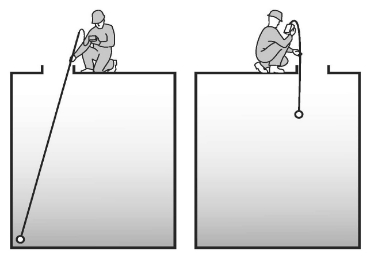
Lighter gases may be vented into the breathing zone of the person conducting the tests. Some gases may be dissolved in liquids and released when the liquid is disturbed or a crust over the liquid is broken and it may therefore be necessary to agitate liquids before monitoring.
If it is necessary to enter the space to test remote regions away from entrances or access holes, then air-supplied respiratory equipment should be worn and the entry must be undertaken in accordance with the WHS Regulations using a confined space entry permit.
Re-testing and continuous monitoring of the air may be necessary if the risk assessment indicates that conditions may change due to the work being done or the disturbance of hazardous material in the confined space.
A single (or generic) risk assessment may be carried out for a class of confined spaces in a number of different work areas or workplaces where the confined spaces are the same. This will only be appropriate if all of the hazards being covered are the same. A risk assessment must be carried out on individual confined spaces if there is any likelihood that a worker may be exposed to greater, additional or different risks.
A confined space entry permit may be used as a record of the risk assessment.
The most important step in the risk management process involves controlling risks by eliminating them so far as is reasonably practicable, or if that is not possible, by minimising
the risks so far as is reasonably practicable.
The ways of controlling risks are ranked from the highest level of protection and reliability to
the lowest. This ranking is known as the hierarchy of control. The WHS Regulations require
duty holders to work through this hierarchy to achieve the highest level of protection that is reasonably practicable in the circumstances.
The most effective control measure is to eliminate the risk, for example, by eliminating the need
to enter a confined space.
If it is not reasonably practicable to eliminate the risk, you must minimise the risks so far as
is reasonably practicable by:
- substituting the hazard giving rise to the risk with something that is safer
- isolating the hazard from any person exposed to it, or
- implementing engineering controls.
If there is a remaining risk, it must be minimised so far as is reasonably practicable by implementing administrative controls, and if a risk still remains, then suitable personal protective equipment must be provided and used. These two types of control measures, when used on their own, tend to be least effective in minimising risks because they rely on human behaviour and supervision.
Some risk control measures are mandatory for confined spaces.
Regulation 66: In managing risks associated with a confined space, all relevant matters must be considered, including:
- whether the work can be carried out without the need to enter the confined space
- the nature of a confined space
- if the hazard is associated with any airborne contaminant or unsafe level of oxygen
- the work to be carried out in the confined space, the range of methods by which the work can be carried out, and the proposed method
- the type of emergency procedures required.
Risks associated with work in a confined space must be eliminated so far as is reasonably practicable, and therefore the first question is: can the work be carried out without entering the confined space?
Work could be carried out from outside the confined space by:
- installing fixed or temporary cleaning devices for example spray balls using high-pressure hoses inserted through an access hatch to clean the inside of a tank
- using remote cameras or a mirror attached to a probe for internal inspection of vessels
- using remotely operated rotating flail devices, vibrators or air purgers to clear blockages
in silos - using a hook, long-handled clasp or magnet on a string to retrieve an object dropped into
a confined space.
If entering a confined space cannot be avoided, then a safe system for working inside the space must be implemented. The identified hazards will help determine what controls are needed to minimise any risk associated with work in the confined space. Under the WHS Regulations, the following matters must be considered:
The nature of a confined space may contribute to the risks associated with it, for example:
- whether the number, size and location of entrances and exits are adequate to enable the rapid exit and rescue of workers from the space
- the temperature of the space so that it will not cause heat stress
- adequate lighting, if there is poor visibility.
The level of oxygen and airborne contaminants is a significant contributor to the risk of working in a confined space, therefore:
- the level of oxygen should be maintained at a safe level and any airborne contaminants in the space are minimised by ventilating prior to and/or during entry
- any changes that may occur to oxygen or airborne contaminants are determined by testing the atmosphere
- where the atmospheric conditions cannot be maintained at a safe level, appropriate respiratory protective equipment must be provided.
Consideration should be given to whether the proposed work or work process will introduce any new hazards or contribute to the risks of working in the confined space. Ignition sources must not be introduced into a space that contains a flammable atmosphere.
Work processes should:
- minimise the release of harmful airborne contaminants into the space
- reduce the time spent in the space or the number of people that have to enter the space
- eliminate the risk of engulfment.
Consider any risks associated with the use of personal protective equipment (PPE) in a confined space. Using PPE may introduce new risks for those working in the space, for example the weight or discomfort of protective clothing and hearing protection.
When things go wrong in a confined space, people may be exposed to serious and immediate danger. Effective arrangements for raising the alarm and carrying out rescue operations in an emergency are essential (refer to Chapter 6 of this Code).
A confined space entry permit provides a formal check to ensure all elements of a safe system of work are in place before people are allowed to enter the confined space. It also provides a means of communication between site management, supervisors and those carrying out the work and ensures that the person conducting the business or undertaking has checked and authorised the entry to the confined space and it is safe to proceed.
Regulation 67: A person conducting a business or undertaking must not allow or direct a worker to enter a confined space to carry out work unless the person has issued a confined space entry permit for the work.
The permit must be completed in writing by a competent person and:
- specify the confined space to which the permit relates
- record the names of persons permitted to enter the confined space and the period of time that the work will be carried out
- set out risk control measures based on the risk assessment, and
- contain space for an acknowledgement that work in the confined space has been completed and all persons have left the space.
Regulation 77: The permit must be kept until the work is completed, or if a notifiable incident occurs, for at least 2 years after the confined space work to which the permit relates is completed.
A competent person is one who has acquired through training, qualification or experience, the knowledge and skills to carry out this task.
A confined space entry permit must be issued for each entry into the confined space. Each permit only applies to one confined space and allows one or more workers to enter that space. A competent person who directs and supervises the work should be nominated and authorised to issue the permit on behalf of the business or undertaking.
A confined space entry permit is also required when a person enters a confined space to conduct the initial hazard identification or risk assessment. The permit may need to be revised after the risk assessment is completed. The confined space entry permit must list the following:
Requirement | |
Confined space to which the permit applies | - The permit form should be designed and completed in such a way as to enable clear identification and recording of the space that each permit applies to.
- A single permit can be used for multiple entries into a space and can be used where there is more than one access point into a single space.
|
Name of any worker permitted to enter the space | |
Period of time that the permit is in operation | - A permit may be required for varying periods of time depending on the time required to complete the work being carried out in a confined space.
- The permit should be re-validated if the person with direct control of work in the space changes, a break in work continuity occurs, changes are made to the work that introduce hazards not addressed by the current permit, or new controls measures are needed.
|
Measures to control the risk | - List the control measures that must be implemented before work commences, for example the isolation of plant and services, purging, ventilation, atmospheric testing, cleaning and signage.
- List the control measures that must be implemented or continued while work is being done in the space, e.g. ventilation, continuous monitoring, respiratory protective equipment and personal protective equipment.
- List any equipment to be taken into the confined space, including any exclusions such as ignition sources.
- List any specialist emergency rescue equipment required.
|
The entry permit must be used as a written record that all workers have exited the confined space on completion of the work. It should be displayed in a prominent place to facilitate signing and clearance. Each worker must be able to understand the entry permit.
The information on the entry permit may be used as a suitable record of the risk assessment that has been carried out. An example of an entry permit is provided at Appendix B.
All potentially hazardous services should be isolated prior to any person entering the confined space.
Isolate to prevent:
- the introduction of contaminants or conditions through piping, ducts, vents, drains, conveyors, service pipes and fire protection equipment
- the activation or energising of machinery in the confined space
- the activation of plant or services outside the confined space that could adversely affect the space (for example heating or refrigerating methods)
- the release of any stored or potential energy in plant
- the inadvertent use of electrical equipment.
If liquids, gases or vapours could enter the confined space the pipe work should be physically isolated.
Isolation measures, for example physically locking, tagging, closing and blanking (see Figure 3) should be supervised or checked at each isolation point. Isolation measures should be supported by systems to ensure that the isolation measures are not removed until all work is complete and all workers have left the space.
Figure 3 Example of tag and lockout with the padlocks of two workers.
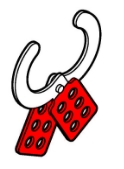
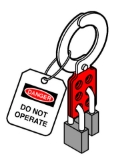
Methods of isolation from materials, contaminants or conditions include isolating in accordance with one of the methods described below or by an alternative method ensuring at least an equivalent level of safety:
- Removing a valve, spool piece or expansion joint in piping leading to the confined space (as close as practicable to the space) and blanking or capping the open end of the piping (see Figure 4). The blank or cap should be tagged to indicate its purpose. Blanks or caps should be made of a material that is compatible with the liquid, vapour or gas with which they are in contact. The material should also have sufficient strength to withstand the maximum operating pressure, for example surges, which can build up in the piping.
Figure 4 Open end of pipe capped. Nearest valve closed locked and tagged.
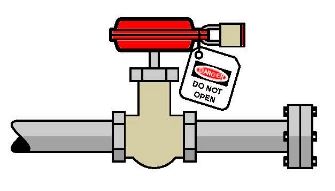
- Inserting a suitable full-pressure spade or blank in piping between the flanges as close as practicable to the confined space (see Figure 5). The full-pressure spade or blank should be tagged to indicate its purpose.
Figure 5 Insertion of full pressure spade or blank. Nearest valve closed, locked and tagged. Spade is also tagged to indicate its purpose.
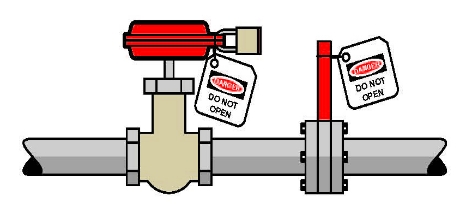
- Closing, locking and tagging at least two valves in the piping leading to the confined space (see Figure 6). A drain or vent valve between the two closed valves should be locked open to atmosphere as part of this method.
Figure 6 Closing, locking and tagging at least two valves
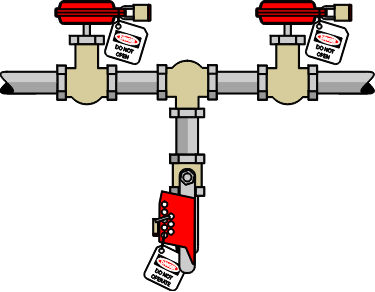
Before entry is permitted to any confined space that can move, or in which agitators, fans or other moving parts that may pose a risk to workers are present, the possibility of movement should be eliminated.
Equipment or devices with stored energy, including hydraulic, pneumatic, electrical, chemical, mechanical, thermal or other types of energy, should be reduced to a zero energy condition so that no energy is left in devices and systems that could cause injury or illness.
If the confined space has agitators, blades and other moving equipment, consider chocking, wedging, chaining or removing these parts. Alternatively de-energise the equipment, lockout and tag out machinery, mixers, agitators and other equipment containing moving parts in the confined space. This may require additional isolation, blocking or de-energising of the machinery itself to guard against the release of stored energy.
When a lock is used, the key should be kept in the possession of the person placing the lock. Spare keys should not be accessible except in emergencies. The tag should indicate that a person is in the confined space and that such isolation should not be removed until all people have left the confined space.
Examples where this procedure may be used include:
- an open circuit breaker or open isolating switch supplying electrical power to equipment with hazardous moving parts
- where a power source cannot be controlled readily or effectively, requiring a belt or other mechanical linkage to be disconnected and tagged.
A safe atmosphere must be ensured, so far as is reasonably practicable, during work in a confined space. A safe atmosphere in a confined space is one that:
- has a safe oxygen level
- is free of airborne contaminants or any airborne contaminants are in concentrations below their allowable exposure standard (if any)
- any flammable gas or vapour in the atmosphere is at concentrations below 5% of its LEL.
A safe atmosphere can be achieved within the confined space using methods such as cleaning, purging and ventilation.
Purging is done using an inert gas, such as nitrogen, to clear flammable gases or vapours before work in the confined space begins.
After purging, the confined space should be adequately ventilated with sufficient fresh air to ensure that the inert gas is removed. Purging should be done in a way that ensures any contaminants removed from the confined space are expelled to a location where they present no further risk. Atmospheric testing should be carried out before entry to check that the ventilation has been effective.
When flammable contaminants are to be purged, purging and ventilation equipment designed for use in hazardous areas must be used. A hazardous area is an area in which an explosive atmosphere is present, or may be expected to be present, in quantities that may require special precautions for the construction, installation and use of potential ignition sources.
The WHS Regulations prohibit pure oxygen or gas mixtures with oxygen in concentration greater than 21% by volume being used for purging or ventilating a confined space because of the risk of increased flammability.
The space must be purged where a risk assessment identifies the potential for the confined space to contain an unacceptable level of contaminants.
Ventilation of a confined space with fresh air, by natural, forced or mechanical means, may be necessary to establish and maintain a safe atmosphere and temperature for as long as anyone is in the confined space.
If the confined space has sufficient openings then natural ventilation may be adequate, but in most cases mechanical ventilation is likely to be needed.
Consideration should also be given to where the fresh air is drawn from and where the exhaust air is finally vented to, so that the fresh air is not contaminated either by exhaust air or by other pollutants, and the exhaust air does not cause other risks.
Mechanical ventilation may be either local exhaust ventilation (LEV) or dilution ventilation. LEV is effective where the source of contaminant generation is localised, the extraction point can be located close to the source and adequate make-up air is available (for example, capture or extraction of welding fume).
Where dilution ventilation is used, air needs to be introduced in a way that will ensure effective circulation throughout the confined space, taking account of the configuration of the space, the position of the openings and the properties of the contaminants.
During operations likely to generate contaminants, mechanical ventilation equipment may not be adequate or sufficiently reliable to maintain contaminants at acceptable levels or to ensure a safe oxygen level. Where mechanical ventilation equipment is likely to be necessary to maintain acceptable contaminant levels in a confined space, the equipment should:
- be monitored to ensure continuous operation while the confined space is occupied
- have the controls (including any remote power supply) clearly identified, tagged and protected to guard against unauthorised interference.
Regulation 72: A person conducting a business or undertaking must, while work is being carried out in a confined space, ensure that the concentration any flammable gas, vapour or mist in the atmosphere of the space is less than 5% of its LEL, so far as is reasonably practicable.
If it is not reasonably practicable, and the concentration of any flammable gas, vapour or mist in the atmosphere of the confined space:
- is equal to or greater than 5% but less than 10% of its LEL—the person must ensure that any worker is immediately removed from the space unless a suitably calibrated, continuous-monitoring flammable gas detector is used in the space; or
- is equal to or greater than 10% of its LEL—the person must ensure that any worker is immediately removed from the space.
Where a flammable atmosphere may exist in a confined space and there is a risk of fire and explosion, all ignition sources in the vicinity must be eliminated.
Examples of potential ignition sources, both inside and outside the space, include:
- open flames and hot surfaces
- electrical equipment
- internal combustion engines
- metal tools striking metal surfaces
- spark-producing equipment for example grinding wheels
- static electricity.
If it is not reasonably practicable to ensure the confined space contains a safe oxygen level,
or safe levels of airborne contaminants, then appropriate respiratory protective equipment must be provided. The respiratory protective equipment should be provided and worn in situations where there is no exposure standard for a substance, or where the substance is present in an unknown concentration.
Respiratory protective equipment refers to a range of breathing equipment, including air-supplied and self-contained breathing apparatus. The appropriate respiratory protective equipment should be based on the level and type of contaminants and the work to be done. Whenever there is any doubt about the type of respiratory protective equipment required,
a conservative approach should be adopted (for instance, use air-supplied respiratory equipment).
Further guidance is available in AS/NZS 1715: Selection, use and maintenance of respiratory protective devices.
Regulation 69: The person conducting a business or undertaking must ensure that a system
of work is provided that includes:
- continuous communication with the worker from outside the confined space
- monitoring conditions within the confined space by a standby person who is in the vicinity
of the confined space, and if practicable, observing the work being carried out.
A communication system is needed to enable communication between people inside and outside the confined space and to summon help in an emergency.
Depending on the conditions in the confined space, communication can be achieved by voice, radio, hand signals or other suitable methods.
Before a worker enters a confined space, a standby person must be assigned to continuously monitor the wellbeing of those inside the space, if practicable observe the work being carried out and initiate appropriate emergency procedures when necessary (see Figure 7).
The standby person should:
- understand the nature of the hazards inside the particular confined space and be able
to recognise signs and symptoms that workers in the confined space may experience - remain outside the confined space and do no other work which may interfere with their primary role of monitoring the workers inside the space
- have all required rescue equipment (for example, safety harnesses, lifting equipment,
a lifeline) immediately available - have the authority to order workers to exit the space if any hazardous situation arises
- never enter the space to attempt rescue.
Figure 7 Standby person monitoring the confined space with rescue equipment and sign in place
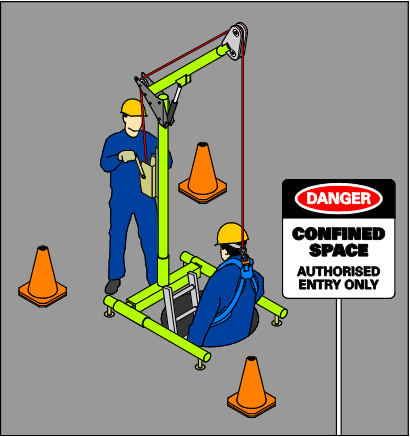
For the entire period the confined space entry permit is valid, procedures should be in place to indicate when any worker is in the space, for example by using tags, a system of signing in and out on the entry permit, or having a standby person record who is in the space.
Before any work in relation to a confined space starts, signs must be erected to prevent entry of persons not involved in the work.
Signs must warn against entry by people other than those who are listed on the confined space entry permit, and must be placed at each entrance to the confined space. Signs must be in place while the confined space is accessible, including when preparing to work in the space, during work in the space and when packing up on completion of the work.
Signposting alone should not be relied on to prevent unauthorised entry to a potential confined space. Security devices, for example locks and fixed barriers, should be installed.
Workers and their supervisors must have the skills and knowledge to understand the hazards associated with working in the confined space, the contents of any confined space entry permit, and the control measures implemented for their protection.
Training should be provided to workers who:
- enter or work in confined spaces
- undertake hazard identification or risk assessment in relation to a confined space
- implement risk control measures
- issue entry permits
- act as a standby person or communicate with workers in a confined space
- monitor conditions while work is being carried out
- purchase equipment for confined space work
- design or lay out a work area that includes a confined space.
Regulation 76: The training provided to relevant workers must cover:
- the nature of all hazards associated with a confined space
- the need for, and appropriate use of, risk control measures
- the selection, use, fit, testing and storage of any personal protective equipment
- the contents of any relevant confined space entry permit
- emergency procedures.
Re-training or refresher training should be provided as appropriate for a particular workplace. The frequency of this training should depend on how often workers are required to carry out tasks associated with entry to or work in confined spaces.
Records of all training provided to workers in relation to confined space work must be kept for 2 years.
Proper maintenance of control measures is an integral part of any safe system of work. Maintenance may involve visual checks, inspections, testing of equipment, preventative maintenance and remedial work. Equipment that should be regularly inspected includes:
- atmospheric testing and sampling equipment
- personal protective equipment including respirators
- ventilation equipment
- safety harness and lines
- emergency rescue equipment.
Regulation 74: A person conducting a business or undertaking must establish first aid and rescue procedures to be followed in an emergency and ensure those procedures are practised as necessary to ensure that they are efficient and effective. First aid and rescue procedures must be initiated from outside the confined space as soon as practicable in an emergency.
The person conducting a business or undertaking must also ensure that openings for entry and exit are of a sufficient size to allow emergency access; openings are not obstructed; and any plant, equipment and personal protective equipment provided for first aid or emergency rescue are maintained in good working order.
When establishing emergency procedures, the following factors must be taken into account to manage risks associated with confined spaces:
- whether the work can be carried out without the need to enter the confined space
- the nature of the confined space
- any changes in hazards associated with the concentration of oxygen or the concentration of airborne contaminants in the confined space
- the work to be carried out in the confined space, the range of methods by which the work can be carried out and the proposed method of working
- the type of emergency and rescue procedures required.
Consideration should also be given to the following:
Relevant considerations | Questions |
Location of the confined space | What is the geographic location of the space, how accessible is it in an emergency and how far away is it from appropriate medical facilities? |
Communications | How can workers working inside the space communicate to people outside in an emergency? Exactly how will the alarm be raised and by whom? Planning needs to ensure that rescue and emergency personnel can access the workplace during night shift, weekends and holiday periods. |
Rescue and resuscitation equipment | What kinds of emergencies are contemplated? The provision of suitable rescue and resuscitation equipment will depend on the potential emergencies identified. Selected rescue equipment should be kept in close proximity to the confined space so that it can be used immediately. |
Capabilities of rescuers | Are rescuers properly trained, sufficiently fit to carry out their task and capable of using any equipment provided for rescue (e.g. breathing apparatus, lifelines and fire-fighting equipment)? How will rescuers be protected during the emergency operation? |
First aid | Is appropriate first aid available for immediate use? Are trained first aid personnel available to make proper use of any necessary first aid equipment? |
Local emergency services—if they are to be relied on for rescue | How will the local emergency services (e.g. fire brigade) be notified of an incident? What information about the particular dangers in the confined space will be given to them on their arrival? Have prior arrangements been made with local emergency services to ensure they are able to respond in a reasonable time and have the specialist confined space retrieval equipment readily available? |
First aid and rescue procedures must be rehearsed with relevant workers to ensure that they are efficient and effective.
Rescue should be performed from outside the confined space, if possible. Workers performing rescue must be adequately trained. Rescuers must be provided with and wear appropriate respiratory protective equipment if they enter a confined space in an emergency.
If a person inside a confined space has been overcome by lack of oxygen or airborne contaminants, it should always be assumed that entry for rescue is unsafe unless air-supplied respiratory protective equipment is used.
Potential problems with the size of entrances and exits must be addressed when developing emergency and rescue procedures. Where openings are found to be inadequate, their size should be increased, or an alternative safe means of entry and exit should be provided.
Control measures that have been implemented must be reviewed, and if necessary, revised to make sure they work as planned and to maintain, so far as is reasonably practicable, a work environment that is without risks to health and safety.
Regulation 38: A person conducting a business or undertaking must review and as necessary revise risk control measures:
- when the control measure does not minimise the risk so far as is reasonably practicable
- before a change at the workplace that is likely to give rise to a new or different health and safety risk that the control measure may not effectively control
- if a new hazard or risk is identified
- if the results of consultation indicate that a review is necessary
- if a health and safety representative requests a review.
Control measures may be reviewed using the same methods as the initial hazard identification step.
In undertaking the review, consult workers involved in the confined space work and their health and safety representatives and consider the following questions:
- Are the control measures working effectively in both their design and operation?
- How effective is the risk assessment process? Are all hazards being identified?
- Are workers actively involved in the risk management process? Are they openly raising health and safety concerns and reporting problems promptly?
- Have new work methods or new equipment made the job safer?
- Are safety procedures being followed?
- Has instruction and training provided to workers been successful?
- If new legislation or new information becomes available, does it indicate current controls may no longer be the most effective?
- Is any change planned to any plant or structure that may create a confined space or change the nature of an existing confined space?
- Has an incident occurred as a result of work carried out in a confined space?
If problems are found, go back to any point in the risk management process, review the information and revise any decisions about controls measures.
| Confined space criteria | Confined space? |
- Description of the space and activity
| A | B | C | D | If the answer to A, B, C and at least one of D is yes, then the space is a confined space. |
Is the space enclosed or partially enclosed | Is the space not designed or intended to be occupied by a person | Is the space designed or intended to be, at normal atmospheric pressure while any person is in the space | Does the space present a risk from: |
Harmful airborne or flammable contaminants | An unsafe oxygen level | Engulfment |
Sewer with access via a vertical ladder | | | | | | | Yes |
Dislodging grain from a silo with sole access through a manhole at the top | | | | | | | Yes |
Cleaning spilled cadmium pigment powder in a shipping container | | | | | | | Yes |
Inspecting a fuel tank in the wing of an aircraft | | | | | | | Yes |
Dislodging a sludge blockage in a drain pit | | | | | | | Yes |
Internal inspection of a new, clean tank prior to commissioning | | | | | | | No |
Internal inspection of an empty cement silo through a door at ground level | | | | | | | No |
Stocktake using an LPG forklift in a fruit cool store | | | | | | | No |
Installing insulation in a roof cavity | | | | | | | No |

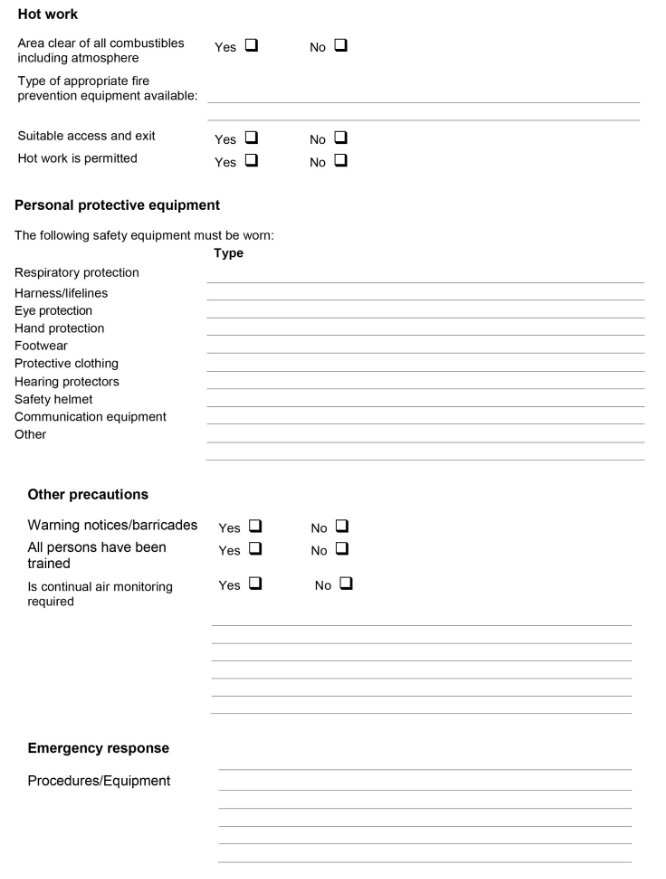
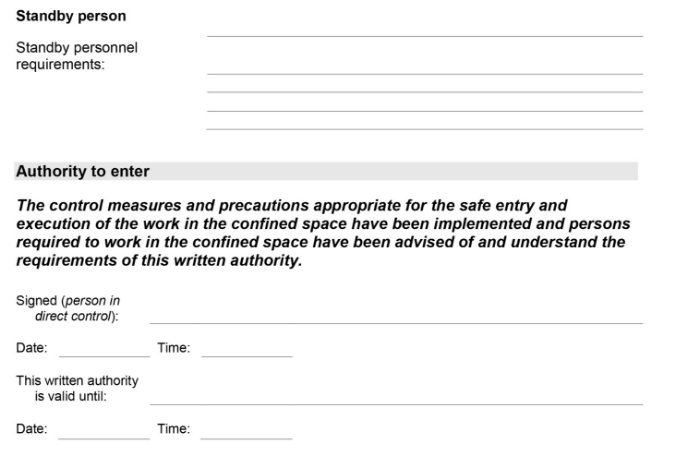
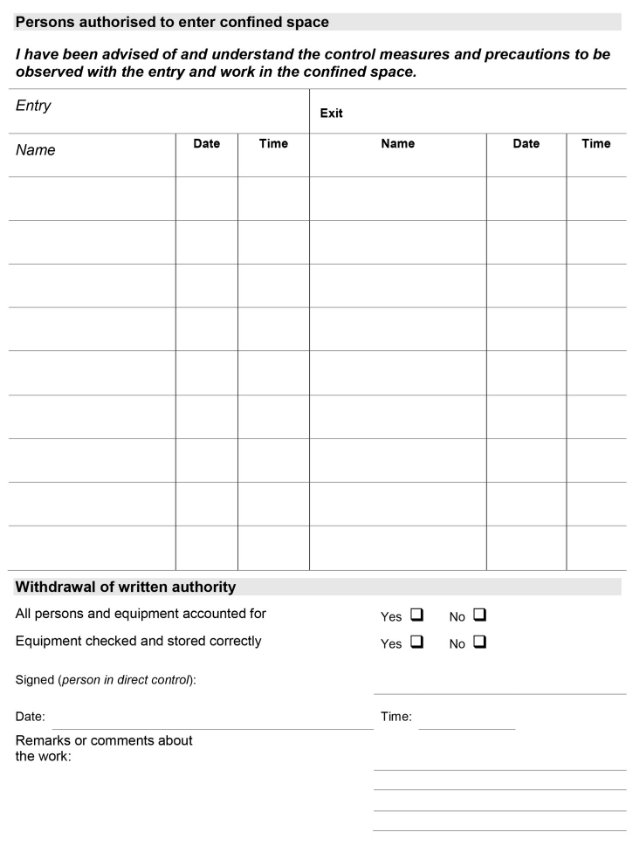
Date | Page Number | Amendments |
19 February 2014 | Front cover | Publication date changed from first published date of December 2011 to republished date of February 2014. |
19 February 2014 | 10 | Section 64 corrected to Regulation 64 in PDF version only. |
![]()












